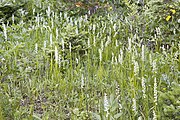-
Scentbottles at Glacier National Park, Montana
-
Inflorescence, British Columbia
| Platanthera dilatata | |
|---|---|

| |
| At Glacier National Park in Montana | |
|
Scientific classification
| |
| Kingdom: | Plantae |
| Clade: | Tracheophytes |
| Clade: | Angiosperms |
| Clade: | Monocots |
| Order: | Asparagales |
| Family: | Orchidaceae |
| Subfamily: | Orchidoideae |
| Genus: | Platanthera |
| Species: | P. dilatata
|
| Binomial name | |
| Platanthera dilatata (Pursh) Lindl. ex L.C.Beck
| |
| Synonyms [1] | |
| |
Platanthera dilatata, known as tall white bog orchid, bog candle, or boreal bog orchid is a species of orchid, a flowering plant in the family Orchidaceae, native to North America. [2] [3] [4] It was first formally described in 1813 by Frederick Traugott Pursh as Orchis dilatata. [5]
It is sometimes called fragrant white bog orchid or scentbottle, for the smell of its flowers, described as intensely spicy or clove-like. [2] [6] [7]
In the Midwest and northeastern United States and Canada, it grows in cold, calcareous fens, cedar and tamarack swamps, meadows, and marshes, typically in sunny spots. [3] [4]
Description
Bog candle is an erect, perennial flower growing up to 11–130 cm (4.3–51.2 in) tall. The showy, white flowers are clustered on long spikes. The petals are ovate to linear-lance shaped with smooth edges, not divided or fringed like some other Platanthera species. The lateral sepals spread or reflex. [2] [3]
The leaves are linear to lanceolate or oblanceolate, and reduce in size toward the top of the plant. The leave size ranges from 3–32 cm (1.2–12.6 in) long to 0.3–7 cm (0.12–2.76 in) across. [2]
Three varieties are accepted: [2]
- Platanthera dilatata var. albiflora – Colorado to Alaska
- Platanthera dilatata var. dilatata – Colorado to Alaska, Great Lakes and northeastern US and Canada, absent in most of the Great Plains
- Platanthera dilatata var. leucostachys — western US and Canada, from southern California to Alaska
Uses
British Columbian Native Americans used the sweet-smelling flowers in washing themselves. [8]
References
- ^ "Platanthera dilatata (Pursh) Lindl. ex L.C.Beck". Plants of the World Online. Royal Botanical Gardens Kew. Retrieved 19 December 2019.
- ^ a b c d e Sheviak, Charles J (2002). "Platanthera dilatata". In Flora of North America Editorial Committee (ed.). Flora of North America North of Mexico (FNA). Vol. 26. New York and Oxford: Oxford University Press. Retrieved 20 December 2019 – via eFloras.org, Missouri Botanical Garden, St. Louis, MO & Harvard University Herbaria, Cambridge, MA.
- ^ a b c "Online Virtual Flora of Wisconsin - Platanthera dilatata". wisflora.herbarium.wisc.edu. Retrieved 20 December 2019.
- ^ a b Reznicek, A. A.; Voss, E. G.; Walters, B. S., eds. (February 2011). "Platanthera dilatata". Michigan Flora Online. University of Michigan Herbarium. Retrieved 20 December 2019.
- ^ "Platanthera dilatata". ipni.org. International Plant Names Index. Retrieved 20 December 2019.
- ^ Brouillet L, Desmet P, Coursol F, Meades SJ, Favreau M, Anions M, Bélisle P, Gendreau C, Shorthouse D, et al. (2010). "Platanthera dilatata (Pursh) Lindley ex L.C. Beck". Database of Vascular Plants of Canada (VASCAN). Retrieved 20 December 2019.
- ^ USDA, NRCS (n.d.). "Platanthera dilatata". The PLANTS Database (plants.usda.gov). Greensboro, North Carolina: National Plant Data Team. Retrieved 20 December 2019.
- ^ Fagan, Damian (2019). Wildflowers of Oregon: A Field Guide to Over 400 Wildflowers, Trees, and Shrubs of the Coast, Cascades, and High Desert. Guilford, CT: FalconGuides. p. 65. ISBN 978-1-4930-3633-2. OCLC 1073035766.

